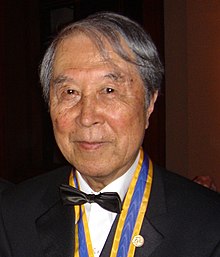
Back يويتشيرو نامبو Arabic يويتشيرو نامبو ARZ یوایچیرو نامبو AZB Ёіціра Намбу Byelorussian Йоичиро Намбу Bulgarian ইয়োইচিরো নাম্বু Bengali/Bangla Yoichiro Nambu BS Yoichiro Nambu Catalan Jóičiró Nambu Czech Yoichiro Nambu Danish
Yoichiro Nambu 南部 陽一郎 | |
|---|---|
 Nambu in 2005 | |
| Born | 18 January 1921 |
| Died | 5 July 2015 (aged 94) |
| Citizenship | American (from 1970) |
| Alma mater | Tokyo Imperial University |
| Known for | Spontaneous symmetry breaking String theory Nambu–Goto action Nambu-Goldstone boson Nambu mechanics Nambu–Jona-Lasinio model |
| Spouse | Chieko Hida |
| Children | John Nambu (son) |
| Awards | Heineman Prize (1970) J. Robert Oppenheimer Memorial Prize (1976) Order of Culture of Japan (1978) US National Medal of Science (1982) Max Planck Medal (1985) Dirac Medal (1986) J.J. Sakurai Prize (1994) Wolf Prize in Physics (1994/1995) Franklin Medal (2005) Pomeranchuk Prize (2007) Nobel Prize in Physics (2008) |
| Scientific career | |
| Fields | Physics |
| Institutions | University of Tokyo (1942–49) Osaka City University (1949–52) Institute for Advanced Study (1952–54) University of Chicago (1954– 2015) |
| Modern physics |
|---|
| |
| Quantum field theory |
|---|
 |
| History |
| Standard Model of particle physics |
|---|
 |
Yoichiro Nambu (南部 陽一郎, Nanbu Yōichirō, 18 January 1921 – 5 July 2015) was a Japanese-American physicist and professor at the University of Chicago.
Known for his contributions to the field of theoretical physics, he was awarded half of the Nobel Prize in Physics in 2008 for the discovery in 1960 of the mechanism of spontaneous broken symmetry in subatomic physics, related at first to the strong interaction's chiral symmetry and later to the electroweak interaction and Higgs mechanism.[1]
The other half was split equally between Makoto Kobayashi and Toshihide Maskawa "for the discovery of the origin of the broken symmetry which predicts the existence of at least three families of quarks in nature."[1]
- ^ a b Nambu, Yoichiro (2008). Karl Grandin (ed.). "Les Prix Nobel – The Nobel Prizes 2008". Stockholm: The Nobel Foundation. Archived from the original on 11 October 2014. Retrieved 19 July 2015.

